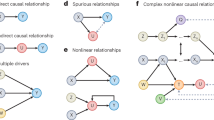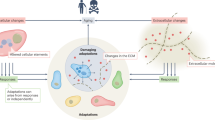Abstract
Two paradigms central to geroscience research are that aging is associated with increased oxidative stress and increased cancer risk. Therefore, it could be deduced that cancers arising with ageing will show evidence of increased oxidative stress. Recent studies of gene expression in age-controlled breast cancer cases indicate that this deduction is false, posing parallax views of these two paradigms, and highlighting the unanswered question: does ageing cause or simply permit cancer development?
This is a preview of subscription content, access via your institution
Access options
Subscribe to this journal
Receive 12 print issues and online access
$209.00 per year
only $17.42 per issue
Buy this article
- Purchase on Springer Link
- Instant access to full article PDF
Prices may be subject to local taxes which are calculated during checkout


Similar content being viewed by others
References
Harman, D. Aging: a theory based on free radical and radiation chemistry. J. Gerontol. 11, 298–300 (1956).
Muller, F. L., Lustgarten, M. S., Jang, Y., Richardson, A. & Van Remmen, H. Trends in oxidative aging theories. Free Radic. Biol. Med. 43, 477–503 (2007).
Finkel, T. & Holbrook, N. J. Oxidants, oxidative stress and the biology of ageing. Nature 408, 239–247 (2000).
Raha, S. & Robinson, B. H. Mitochondria, oxygen free radicals, disease and ageing. Trends Biochem. Sci. 25, 502–508 (2000).
Krishnan, K. J., Greaves, L. C., Reeve, A. K. & Turnbull, D. The ageing mitochondrial genome. Nucleic Acids Res. 35, 7399–7405 (2007).
Gruber, J., Schaffer, S. & Halliwell, B. The mitochondrial free radical theory of ageing — where do we stand? Front Biosci. 13, 6554–6479 (2008).
Vijg, J. & Campisi, J. Puzzles, promises and a cure for ageing. Nature 454, 1065–1071 (2008).
Edwards, B. et al. Annual report to the nation on the status of cancer, 1973–1999, featuring implications of age and aging on U.S. cancer burden. Cancer 94, 2766–2792 (2002).
Thun, M. & Jemal, A. Cancer Epidemiology (BC Decker, Hamilton, 2006).
Ershler, W. B. & Longo, D. L. Aging and cancer: issues of basic and clinical science. J. Natl Cancer Inst. 89, 1489–1497 (1997).
Balducci, L. & Ershler, W. B. Cancer and ageing: a nexus at several levels. Nature Rev. Cancer 5, 655–662 (2005).
Benz, C. C., Campisi, J., Cohen, H. J., Ershler, W.B. & Irminger-Finger, I. Meeting report: translational research at the aging and cancer interface. Cancer Res. 67, 4560–4563 (2007).
Pawelec, G. & Solana, R. Are cancer and aging different sides of the same coin? Conference on cancer and ageing. EMBO Rep. 9, 234–238 (2008).
Geigl, J. B. et al. Analysis of gene expression patterns and chromosomal changes associated with aging. Cancer Res. 64, 8550–8557 (2004).
Ly, D. H., Lockhart, D. J., Lerner, R. A. & Schultz, P. G. Mitotic misregulation and human aging. Science 287, 2486–2492 (2000).
Issa, J. P. Aging, DNA methylation and cancer. Crit. Rev. Oncol. Hematol. 32, 31–43 (1999).
Richardson, B. Impact of aging on DNA methylation. Ageing Res. Rev. 2, 245–261 (2003).
DePinho, R. A. The age of cancer. Nature 408, 248–254 (2000).
Yau, C. et al. Aging impacts transcriptomes but not genomes of hormone-dependent breast cancers. Breast Cancer Res. 9, R59 (2007).
Benz, C. C. Impact of aging on the biology of breast cancer. Crit. Rev. Oncol. Hematol. 66, 65–74 (2008).
Halliwell, B. Oxidative stress and cancer: have we moved forward? Biochem. J. 401, 1–11 (2007).
Lander, H. M. An essential role for free radicals and derived species in signal transduction. FASEB J. 11, 118–124 (1997).
Felty, Q., Singh, K. P. & Roy, D. Estrogen-induced G1/S transition of G0-arrested estrogen-dependent breast cancer cells is regulated by mitochondrial oxidant signaling. Oncogene 24, 4883–4893 (2005).
Oberley, T. D., Allen, R. G., Schultz, J. L. & Lauchner, L. J. Antioxidant enzymes and steroid-induced proliferation of kidney tubular cells. Free Radic. Biol. Med. 10, 79–83 (1991).
Patel, M. M. & Bhat, H.K. Differential oxidant potential of carcinogenic and weakly carcinogenic estrogens: Involvement of metabolic activation and cytochrome P450. J. Biochem. Mol. Toxicol. 18, 37–42 (2004).
Bhat, H. K., Calaf, G., Hei, T. K., Loya, T. & Vadgama, J. V. Critical role of oxidative stress in estrogen-induced carcinogenesis. Proc. Natl Acad. Sci. USA 100, 3913–3918 (2003).
Dairkee, S. H. et al. Oxidative stress pathways highlighted in tumor cell immortalization: association with breast cancer outcome. Oncogene 26, 6269–6279 (2007).
Beckman, K. B. & Ames, B. N. The free radical theory of aging matures. Physiol. Rev. 78, 547–581 (1998).
Moghaddam, A. et al. Thymidine phosphorylase is angiogenic and promotes tumor growth. Proc. Natl Acad. Sci. USA 92, 998–1002 (1995).
Sipe, H. J. Jr, Jordan, S. J., Hanna, P. M. & Mason, R. P. The metabolism of 17β-estradiol by lactoperoxidase: a possible source of oxidative stress in breast cancer. Carcinogenesis 15, 2637–2643 (1994).
Blackburn, R. V. et al. Metabolic oxidative stress activates signal transduction and gene expression during glucose deprivation in human tumor cells. Free Radic. Biol. Med. 26, 419–430 (1999).
Li, C. & Jackson, R. M. Reactive species mechanisms of cellular hypoxia-reoxygenation injury. Am. J. Physiol. Cell Physiol. 282, C227–C241 (2002).
Grimshaw, M. J., Naylor, S. & Balkwill, F. R. Endothelin-2 is a hypoxia-induced autocrine survival factor for breast tumor cells. Mol. Cancer Ther. 1, 1273–1281 (2002).
Grimshaw, M. J., Wilson, J. L. & Balkwill, F. R. Endothelin-2 is a macrophage chemoattractant: implications for macrophage distribution in tumors. Eur. J. Immunol. 32, 2393–2400 (2002).
Liang, X. et al. Oxidant stress impaired DNA-binding of estrogen receptor from human breast cancer. Mol. Cell Endocrinol. 146, 151–161 (1998).
Wu, X., Bishopric, N. H., Discher, D. J., Murphy, B. J. & Webster, K. A. Physical and functional sensitivity of zinc finger transcription factors to redox change. Mol. Cell Biol. 16, 1035–1046 (1996).
Quong, J. et al. Age-dependent changes in breast cancer hormone receptors and oxidant stress markers. Breast Cancer Res. Treat. 76, 221–236 (2002).
Scott, G. K., Kushner, P., Vigne, J. L. & Benz, C. C. Truncated forms of DNA-binding estrogen receptors in human breast cancer. J. Clin. Invest. 88, 700–706 (1991).
Valko, M., Rhodes, C. J., Moncol, J., Izakovic, M. & Mazur, M. Free radicals, metals and antioxidants in oxidative stress-induced cancer. Chem. Biol. Interact. 160, 1–40 (2006).
Levin, E. R. Bidirectional signaling between the estrogen receptor and the epidermal growth factor receptor. Mol. Endocrinol. 17, 309–317 (2003).
Kirkegaard, T. et al. AKT activation predicts outcome in breast cancer patients treated with tamoxifen. J. Pathol. 207, 139–146 (2005).
Knowlden, J. M. et al. Elevated levels of epidermal growth factor receptor/c-erbB2 heterodimers mediate an autocrine growth regulatory pathway in tamoxifen-resistant MCF-7 Cells. Endocrinology 144, 1032–1044 (2003).
Nabha, S. M. et al. Upregulation of PKC-δ contributes to antiestrogen resistance in mammary tumor cells. Oncogene 24, 3166–3176 (2005).
Gee, J. M. et al. Epidermal growth factor receptor/HER2/insulin-like growth factor receptor signalling and oestrogen receptor activity in clinical breast cancer. Endocr. Relat. Cancer 12, S99–S111 (2005).
Oh, A. S. et al. Hyperactivation of MAPK induces loss of ERα expression in breast cancer cells. Mol. Endocrinol. 15, 1344–1359 (2001).
Creighton, C. J. et al. Activation of mitogen-activated protein kinase in estrogen receptor a-positive breast cancer cells in vitro induces an in vivo molecular phenotype of estrogen receptor α-negative human breast tumors. Cancer Res. 66, 3903–3911 (2006).
Creighton, C. J. et al. Genes regulated by estrogen in breast tumor cells in vitro are similarly regulated in vivo in tumor xenografts and human breast tumors. Genome Biol. 7, R28 (2006).
Coser, K. R. et al. Global analysis of ligand sensitivity of estrogen inducible and suppressible genes in MCF7/BUS breast cancer cells by DNA microarray. Proc. Natl Acad. Sci. USA 1000, 13994–13999 (2003).
Lin, C. Y. et al. Discovery of estrogen receptor α target genes and response elements in breast tumor cells. Genome Biol. 5, R66 (2004).
Oh, D. S. et al. Estrogen-regulated genes predict survival in hormone receptor-positive breast cancers. J. Clin. Oncol. 24, 1656–1664 (2006).
Vendrell, J. A. et al. Estrogen regulation in human breast cancer cells of new downstream gene targets involved in estrogen metabolism, cell proliferation and cell transformation. J. Mol. Endocrinol. 32, 397–414 (2004).
Yau, C. & Benz, C. C. Genes responsive to both oxidant stress and loss of estrogen receptor (ER) function identify a poor prognosis group of ER-positive primary breast cancers. Breast Cancer Res. 10, R61 (2008).
Zhou, Y. et al. Enhanced NFkB and AP-1 transcriptional activity associated with antiestrogen resistant breast cancer. BMC Cancer 7, 59 (2007).
Zhou, Y. et al. Activation of nuclear factor κB (NFκB) identifies a high-risk subset of hormone-dependent breast cancers. Int. J. Biochem. Cell Biol. 37, 1130–1144 (2005).
Harding, C., Pompei, F., Lee, E. E. & Wilson, R. Cancer suppression at old age. Cancer Res. 68, 4465–4478 (2008).
Campisi, J. & d'Adda di Fagagna, F. Cellular senescence: when bad things happen to good cells. Nature Rev. Mol. Cell Biol. 8, 729–740 (2007).
Zhang, H., Ramanathan, Y., Soteropoulos, P., Recce, M. L. & Toias, P. P. EZ-Retrieve: a web-server for batch retrieval of coordinate-specified human DNA sequences and underscoring putative transcription factor-binding sites. Nucleic Acid Res. 30, e121 (2002).
Heinemeyer, T. et al. Databases on transcriptional regulation: TRANSFAC, TRRD and COMPEL. Nucleic Acid Res. 26, 364–370 (1998).
Acknowledgements
The authors' work is supported in part by National Institutes of Health grants R01-AG020521, R01-CA71468, P01-AG025901, U54-RR024346/RL1-AG032113, P50-CA58207, and Hazel P. Munroe memorial funding to the Buck Institute.
Author information
Authors and Affiliations
Corresponding author
Related links
Related links
DATABASES
National Cancer institute
FURTHER INFORMATION
Rights and permissions
About this article
Cite this article
Benz, C., Yau, C. Ageing, oxidative stress and cancer: paradigms in parallax. Nat Rev Cancer 8, 875–879 (2008). https://doi.org/10.1038/nrc2522
Issue Date:
DOI: https://doi.org/10.1038/nrc2522
This article is cited by
-
Targeting aging and age-related diseases with vaccines
Nature Aging (2024)
-
The TSP1-CD47-SIRPα interactome: an immune triangle for the checkpoint era
Cancer Immunology, Immunotherapy (2023)
-
Stress-induced changes in CARF expression determine cell fate to death, survival, or malignant transformation
Cell Stress and Chaperones (2020)



